Swapping a post at Winchcombe
Several weeks of planning culminated on Friday in the successful swapping of a yard lamp post on Winchcombe platform 2, for an 8ft standard platform example.
Below is the 'before' situation.
Note the height of the post, with a rather small looking lamp on top.
The idea of the taller post here was to light the footbridge, but it turned out in practice that it was too tall. Not only is a yard lamp twice as high above ground (at 13ft 6ins) than a standard platform lamp (at 6ft), but this one has been stood on the ground instead of buried in it, which added another 2ft 6 ins. to its actual height.
After a while concerns were raised how to safely change the lightbulb, or to remove the rust streaking down it, and paint it. We therefore agreed with the Friends of Winchcombe Station to remove the overtall yard lamp post, and replace it with an 8ft example, which is still 2ft taller than a standard platform post, but is more easily reachable with a single ladder.
The drawing above shows the three types of cast iron lamp posts used by the GWR. It's a 1936 drawing, reproduced by BR, which we scanned from the most useful book on GWR architecture, Great Western Architecture by A. Vaughan. It's well worth buying.
The yard lamp post at Winchcombe is the third from the left, and the replacement we used is the second from the left. The first on the left is the standard GWR platform post, being 6ft above ground, and within easy reach of the lamp man without a ladder. Note that they are all buried in the ground.
 |
| Just how tall is this post? |
It took quite a long time to get all our ducks in line, but Friday was the day, and everything came out perfectly.
In the picture you can see Walt, who volunteered to drive the Telehandler, sizing up the job. The sling for it is on the fence, but where is the centre of gravity?
The post has been isolated from the electric supply, with this panel opened at the bottom. The panel is a non-standard add-on, as normally the octagonal bottom 2ft 6ins are buried in the ground.
First thing, Neal and Yours Truly set off in the Transit to pick up the man basket from Toddington. Walt positioned the Telehandler, and with the basket firmly attached to the forks Neal soared to new heights.
The strap was them moved to the centre of gravity, and the post lifted sideways over the fence.
Soon the Telehandler could be seen advancing down the grass behind the fence - fortunately rock hard, due to the drought - and after checking for errant Deltics, we waved it over the barrow crossing.
The post was then taken to the waiting Transit in the yard.
The return load was one of the two 8ft posts that were donated recently by a supporter near Wells. They are formerly from Keynsham, and are unusual in that while they give the 8ft height above ground, they do not have the 2ft 6ins casting that goes below ground. Instead these (1930s?) posts bolt directly on to a slab in the ground.
 |
| Back over the barrow crossing with the smaller load. |
One of the preparations we did was to measure the bolt holes in the base of the Keynsham posts, and compare with the bolts to which the yard lamp was secured. Thank God for GWR standardisation: they were the same! So in principle all we had to do with the new post was drop it straight in. But would it really fit?
Then there was a short interruption from 'a drone' - the Deltic with its footplate experience came by.
55019 ROYAL HIGHLAND FUSILIER slowly draws into Winchcombe station.
Deltic 55019 is about to set off again here, over our 14 mile line.
Back at the farm the lads had the post screwed down, and were fitting the top back on.
Now the ladder fits - it's much more suitable at this height.
At the end of the afternoon, the scene at the bottom of the steps looked like this:
A more normal sized post, still larger than standard, and with the same lamp top, which now looks much more in proportion.
The FoWS will complete the wiring up, and give the post its final coats of chocolate and cream.
The yard lamp post was taken to Toddington.
We put it here, by the inspection pit and coaling area, which could do with a genuine GWR lamp, in this area, overseen by passing trains.
The final decision rests with the steam dept. A possible alternative use would be next to the future turntable, although that is probably some time away yet. We still have to find £600 for a special yard lamp top, like the ones by the water tower.
As we left, 55019 ROYAL HIGHLAND FUSILIER drifted back into Toddington. We trust that its candidate drivers enjoyed themselves, and that some cash was left over for the GWSR.
Saturday on the PWay.
A lightly smaller gang than usual - 5 of us. Some are away on holiday, it's what you get in summer.
The stalwarts Bert, Dave, Jim, Nick and Yours Truly met for doughnuts and tea in the as yet cool mess coach. It was soon to change!
We set off for that very long straight, between Greet and Prescott, where the Dixton straight starts (another long one, but now in a cutting).
Out today were Dinmore Manor and Foremarke Hall, arranged so that one moment you got two tenders facing you, then next time, two smokeboxes.
The day started with the tenders.
Given the trouble we are having with the back packs for the Interflon, Dave decided to try a small spray gun that we happened to have.
This worked quite well, albeit with an aperture that could be a tad smaller, and the fact that you had to bend down.
One back pack works; to have a second option would double our efficiency.
The second tender met us while we were setting out the site boards.
Here is one end of today's site, at MP 14/I. It's along that very long and very high embankment. You get a grandiose view of Bredon Hill across the valley here.
As we had a rather long work discussion before setting off, by the time we were on site and had the site boards set out, it was already time for lunch.
 |
| Consumer testing of a random batch of bacon baps today. |
Here we need to make a public service announcement, at the request of two volunteers from the 'Bacon Bap to my door department'. Unlike stated last time, we PWay volunteers do not in fact pay full price for these baps, and we do get a discount. We hope this sets the record straight. Yours truly was confused by the frequent purchase of ice creams, which are indeed full price, but bacon baps (which are home made) certainly allow for a discount for us workers.
Right. Baps consumed, we really must get to work. This long stretch is probably the bumpiest of all the 14 mile railway we call our own. It could do with re-sleepering, and the rail ends cropping. It's on a long to do list. In the meantime, we have to spot resleeper, and jack and pack as required.
 |
| Nick (centre) has it easy, Jim (right) has it easier still. |
This jacking and packing is made so much easier by our sponsored Robels, and this increased productivity allowed us to address several spots today, instead of the previous one or two with hand beaters and digging out with shovels.
Later in the day we had the other effect for our photographs - two trains, each with the smokebox leading. Here they are then. It's pretty out here.
We kept moving our site boards along bit by bit, so that several dips could be addressed. We had two men on Robels, with two more on shovels, scooping up supplies of ballast to fill the holes left behind after tamping.
Having done a lot of smaller jobs (i.e. dipped joints) we left the largest one to the end of the day. That was also the hottest part.
This large job concerned a dip in a 10 yard section of track, here by this tree. At first we could not see why there was a dip here, both in the track and in the haul road.
After a good look round the site we think we know: It's the four trees on the left (Malvern side) which are sucking water out of the ground. They are oaks, which have a large root footprint. Possibly because of the drought they are using up more groundwater, which results in ground movement. You can see a slight 'wobble' in the LH rail in the above photograph.
As we got here late in the day, and it's quite a big job, we will address this next time.
Wednesday with the Usketeers.
Well, that became Thursday, hence the blog post a day later than usual. Three out of the five of us had to attend to something else yesterday, so a last minute adjournment was arranged.
It may be hot, but we are still up for it, and have the oak tree to shade us.
Having got more sand first thing, we set Dave and Paul up with some muck, and then profited from the very dry weather to apply a coat of chestnut brown to the door, which was cleaned and primered last time.
Diesel haulage today, so it was guess the loco from its engine noise, as we sat and had our coffee.
It was met at Winchcombe by the Peak. That had some sorts of fans blowing and sounded rather different, so Yours Truly confidently identified it from under the oak tree as 'that Deltic'.
Alas...
We had a quick chat with the class 37 crew - what was the smoke drifting out from under the front?
Answer: It's oil vapour from the vacuum exhauster.
So now you know...
Once the diesels had growled onwards we returned to Paul and Dave to find them inside and backing up.
They were working on the back of the northern gable end, backing up the two courses that were laid last week. Yes, every course of facing blocks needs another behind it to back it up, and make up that fat 16 inch wall.
 |
| Paul's side, just started. |
 |
| Dave's side, also just started. |
To give us a bit more room underneath while building up the gable ends, we took out the second to last truss. You might recall that Paul planned for this by wrapping the ends in DPC, so that they wouldn't stick to the mortar.
So yes, the truss came out easily. Yours Truly caught it from underneath and staggered away with it.
An hour later we had another meeting of the diesels, as the trains crossed at Winchcombe. Business was very modest today (and yesterday). Is it the heat? Or the traction? Well, one leads to the other, the fire risk is currently high.
Our new bag of sand is evident here. The one we got last week, sold to us as sharp sand, turned out not to be sharp when we started using it. It looked OK at first glance, and we were mostly interested in maintaining the red colour. We think we can use it inside, although our mortar needs it, according to the instructions.
We made a short day of it, as a couple of hours were lost at the beginning, getting the extra bag of sand. Above is Paul's corner, with a layer of rough blocks added on, and not quite reaching the middle.
On the other end is Dave's work, also a course that didn't quite reach the middle.
Yes, next week we have to do the middle ! The stones are already up there.
Steam engines at Broadway
Although we are currently running diesel haulage due to the fire risk at the moment, there was a bit of steam at Broadway a couple of days ago:
Two beautifully built model traction engines, that chuffed up the drive from the Caravan Club, to take a look around platform 1.
Ukraine 2003.
A topical subject, and if you want to know what the country is like during peaceful times, and you like railways, take a look at the two Flickr albums that we created:
https://www.flickr.com/photos/73536293@N02/albums/72157660959544482
This one is from 1998, and was with the LCGB, so hardened cases who wanted to see nothing but railways. We certainly got that, and some of those pictures are now very interesting records, with lots of infrastructure and huge steam engines like the P36s, LVs and Es.
In 2003 we went back, this time with a Dutch travel organisation, but led by a railway enthusiast friend. These are the pictures that have just been put up:
https://www.flickr.com/photos/73536293@N02/albums/72177720299414154
The transport and accommodation was the same Dzherelo hotel train in both cases, but the Dutch participants wanted a bit more tourism, with just one day devoted to steam, which was in the magnificent Carpathian mountains. So here you get more daily life, and a few more Soviet curiosities.
Hope you like them. Ukraine is a lovely country.


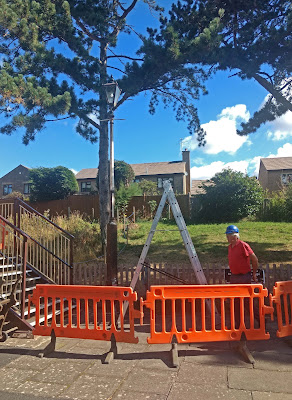
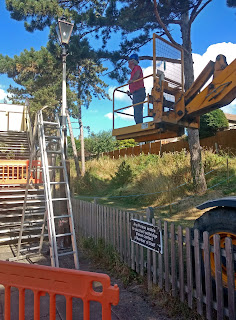




























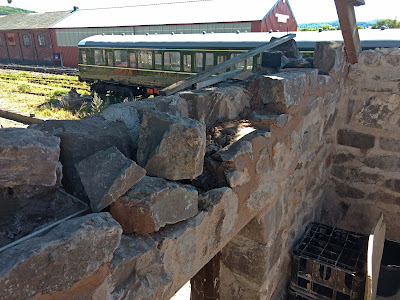
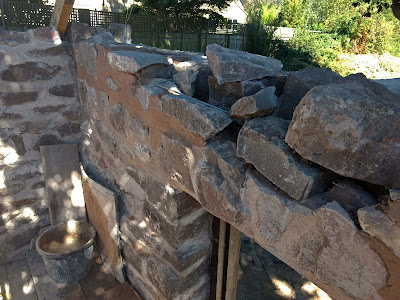
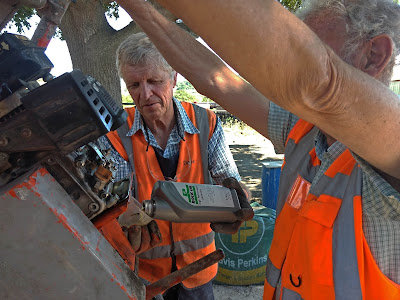

wonderful pictures of Ukraine and its railways - most impressive.
ReplyDeleteIt was a fascinating country, with vast expanses of fields. When we checked out a local village, people gave us fruit - they were very kind. We liked them.
DeleteWow - Heritage Site ALWAYS has a load of interesting topics. Keep up the good work really APPRECIATE the 'snippets' eg Lamp at Toddington;, Uskeeters shinnangans; even the small traction engines at Broadway PLUS the Ukranian locos. Thanks for YOUR patience and keep up the great work. Happydaze from 'down under' KR Jon Bribie Island (near Brisbane)
ReplyDeleteI can hear the 'Strine' now....
DeleteJo, Where is the location of the 'dip in the 10 yard' section. Is it between the Tirle Brook culvert and Prescott Road Bridge (difficult to be certain from the angle of view). If so, your problem may be a collapsed badger sett. This was on a long-term list (back in 2017) to get looked at when a budget could be found. Probably still waiting foe the budget!
ReplyDeleteAndy P.
The dip is by 2 trees, pretty much opposite Sonia Rolt's former house.
DeleteExcellent job with the lamp exchange. Only thing is that the footbridge stairs side rails really look out of place now. Maybe some sheeting like at the top of the stairs could be fitted to make it look the part?. (Both sides of course).
ReplyDeleteThe Interflon backpacks seem to be a pain in the proverbial. What do the makers have to say about their continual failure?
Quite honestly, I didn't expect to see any progress with the Usk hut this week due to the heat. But you persevered. Well done! On the subject of the dock surfacing. I think that the GWR would probably have surfaced a similar dock with blue pavers. However, it does depend upon how mant you have at your disposal, and also laying them is a slow process. Whatever you decide it will look good as in all your projects.
Regards, Paul.
A good layer of loco ash is all that’s needed, wouldn’t cost anything and can be topped up whenever the platform fill settles as it has at every other platform on the line.
DeleteWe don't actually have any diamond pattern pavers. They look nice, but weeds tend to creep up in between.
DeleteAsh would be authentic, but is it legal today to use ash?
We certainly have plenty of it at Toddington, and might even save them a bob or two in disposal. But is it legal?
The entire site at Didcot is covered in the stuff and the public are aloud to wander around over it. A few google searches comes up with nothing to say it’s not aloud.
ReplyDelete